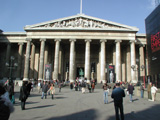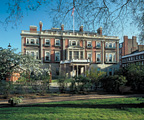Facing the Modern: The Portrait in Vienna 1900
Originally published in September 2013 in American in Britain magazine Autumn 2013
The National Gallery’s current exhibition, Facing the Modern: The Portrait in Vienna 1900 explores changing visual conventions in portrait painting at the turn of the twentieth century. Throughout this period liberal and democratic reforms were ushered in by the Ausgleich (Compromise) of 1867.
Facing the Modern: The Portrait in Vienna 1900
By Abby Cronin
The National Gallery’s current exhibition, Facing the Modern: The Portrait in Vienna 1900 explores changing visual conventions in portrait painting at the turn of the twentieth century. Throughout this period liberal and democratic reforms were ushered in by the Ausgleich (Compromise) of 1867. Religious freedom, together with an expanding multi-faith, multi-national population, promoted urban and economic renewal. The State recognised equality of the many languages spoken, with the exception of Yiddish. These changes attracted vastly diverse groups to the city, and the population virtually doubled between 1880 and 1890. There were numerous national groups, including many with Jewish backgrounds
The effect of the liberal and democratic reforms posed a threat to the established social position of the ‘Old Viennese’ upper-middle classes (Bürgertum). They held on to conservative traditions of ancestral belonging and identity which confirmed their place in the social order throughout the 1860s and 1870s. But with the arrival of the ‘New Viennese’, social positions in hierarchical Viennese society were changing. The ‘New Viennese’, consisting mainly of Jewish audiences, championed modernism, avant-garde artistic experimentation and moral emancipation. But in the late 1800s, as the economy became less stable, liberal sympathies came under threat. A divided political spectrum fostered the emergence of nationalist, conservative and anti-Semitic mass movements, which challenged modernism in the visual arts as well as music, theatre and literature.
‘Who was who’ in middle class Vienna, 1900? Given the changing political and cultural climate, one way of viewing ‘who was who’ in mainly Christian Viennese society was revealed through portraiture. Portraits revealed the city’s middle classes at their most aspirational. Although the most important artistic style of portraiture was a painting on canvas, works could also take the form of drawings, photographs, postcards and even death masks. Wealthy sitters could choose from a variety of artists, depending on how they wished to be portrayed and how they wished to be perceived by their peers. If they wanted a traditional image, they tended to choose artists with established professional affiliations. But if they wanted a more modern image, wealthy patrons could commission artists affiliated with Modernism and the Secessionist movement founded by Gustav Klimt 1897.
Portraits intertwine with patronage, politics and the creation of taste. They tell a story which helps to establish the sitter’s identity. And while that identity might be ancestral or contemporary, the visual representation of the sitter is shown in a specific historical and cultural context. Interpreting the visual presentation involves recognising the medium, the scale, dress, even posture. One’s status could be demonstrated and confirmed by a uniform, a rope of pearls, a tiara. Interior furnishings also mattered, for they are integral elements revealing the social position and lifestyle of the individual.
The portraits in the exhibition establish a dialogue between Beidermeier (Old Viennese) and Modern (New Viennese) periods that began with the formation of the Secessionist movement in 1897. Secessionist artists explored the possibilities of art outside the confines of academic traditions. They developed new styles that owed nothing to historical precedents. Rather, their styles and innovative approaches were in keeping with the progressive and iconoclastic spirit of turn-of-the-century Vienna. They understood the influence of Freud’s writings and introduced a psychological dimension to their portraits. Klimt, the most famous Secessionist portraitist in Vienna, is well known to us today. His iconic portraits convey a changing style in art at a time when the avant-garde redefined traditions in portrait painting. During Klimt’s career there was an increase in the number of private patrons and a growing privatisation of the European art market. The works of Klimt, Schiele, Kokoschka and their Viennese contemporaries represent a response to modern art movements in the West.
Klimt’s portraits display a refinement of decoration that fills the canvas around the sitter. Both the beauty of his sitters and the surrounding decorative aspects capture and define the subject’s social identity. His clientele came mainly from the upper middle classes and aspired to higher social positions. They wanted distinctly modern portraits and had little interest in competing with the conventions of established aristocratic families. Seen here is the stunning portrait of Hermine Gallia (1904), a work for which Klimt made several preparatory drawings. The portrait displays Gallia in a vertical full-length dress which flows like a stream of water along the contours of her body. As with so many of Klimt’s portraits, clothing seems to melt and merge. A subtle ornamental—almost oriental—exotic style surrounds Gallia, who is seen gazing out of the portrait. Even more remarkable is the portrait of Amalie Zuckerkandl (1917-18) which shows the influence of Fauvism. It is not really clear if Amalie is seated or standing. Here colour is more pronounced and the work moves toward abstraction while highlighting Amalie’s very distinctive face.
Egon Schiele, a contemporary of Klimt, painted through what has been described as a Freudian lens. His self-portraits took his own body as a medium of expression. His image in Self-Portrait With Raised Bare Shoulder (1912) reveals a tortured figure painted in thick, expressive strokes from a highly coloured palette. And in his self-portrait of The Family (1918) there is an aura of deep angst. Schiele’s portraiture was regarded as ‘outside’ and marginal to Viennese society. So too was Isidore Kaufmann who painted the Young Rabbi from N (1910). ‘Kaufmann’s rabbi stands as a witness against anti-Semitic accusations that Jews were “ugly” and “disrespectful”. Significantly, his rabbi exists to address the cultural difference of Jews actively engaging in public debate about their position in society in order to find shared platforms for culture’.(*) In contrast to Kaufmann’s rabbi, Klimt and others had wealthy middle-class Jewish sitters—patrons who strongly identified with Western European culture and wished to demonstrate their respectable position in Viennese society.
Vivid contrasts in portraiture reveal how the upper-middle classes in 1900 Vienna chose to portray themselves. Whose culture was on display? When Carl Moll curated a portraiture exhibition at the progressive Galerie Meithke in 1905, he filled this important presentation with older art, regarded by many as outmoded. Moll was fully aware of the work of the moderns but in his self-portrait (1906) he presented himself in the style of the past—within the Biedermeier period. In his portrait he presents himself as a professional working at home, at the desk in his study. The setting and style appear Biedermeier even though the portrait was painted in 1906. Moll’s portraits are more about looking to the Austrian past rather than contemporary styles. A much earlier example is Waldmüller’s Portrait of Schaumberg’s Wife (1846). This mid-century alt-Wiener portrait features Schumberg’s wife painted in a traditional style. It is interpreted as representing Schumberg’s affection for his wife. But it also shows the importance of domestic life and family values characteristic of middle-class Viennese in this period.
Assembling the portraits has been a challenging task for curator Gemma Blackshaw; her co-curator, Chris Riopelle; and Alan Farley, who helped to design the layout. They have devised a way of displaying the portraits that will keep visitors engaged. Space in the main and largest exhibition room is organised using a false wall that runs through the middle, with portraits shown on both sides, creating a sort of ‘portrait corridor’. This, Blackshaw explains, is exactly how portraits were originally shown at the time. Facing the Modern: The Portrait in Vienna 1900 is a remarkably ambitious venture. The curators have drawn on extensive scholarship and research to find portraits lost long ago either in archives or owned by private lenders. By bringing these portraits together we can learn a great deal about the middle-class cultural milieu and changing visual conventions in Vienna at the turn of the 20th century.
______________________________________________________________________________
Facing the Modern: The Portrait in Vienna 1900
Exhibition Dates: 9 October 2013 -12 January 2014
National Gallery. Trafalgar Square, London WC2N 5DN
http://www.nationalgallery.org.uk/visiting/
Catalogue: FACING THE MODERN: THE PORTRAIT IN VIENNA 1900 .Gemma Blachshaw (editor) with an Introduction by Edmund DE WAAL (*p.159—Shapira)
_______________________________________________________________________________________
CONTACT: Abby Cronin
artsjournalist@abbycronin.co.uk
Website: www.abbycronin.co.uk




